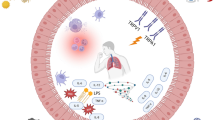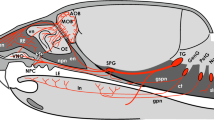Abstract
Pain and itch sensations are induced by depolarization of distinct populations of unmyelinated type C, and possibly other, neurons. Both sets of neurons and sensations serve critical protective mechanisms that maintain the integrity and patency of the upper airways. When noxious or pruritic stimuli are applied on the afferent nerve ending, pain and itch are appreciated at the thalamic and parietal cortex. In the mucosa, this neuronal depolarization spreads via the peripheral efferent axon response mechanism. Neuropeptides such as substance P and calcitonin gene-related peptide are released from neurosecretory varicosities on the nociceptive C fibers. The exact functions of axon responses differ between humans and rodents, and in health and disease. Separate itch- and pain-specific peripheral type C fibers, secondary relay interneurons in the spinal cord dorsal horn, anatomical locations in the lateral spinothalamic tract, and thalamic nuclei demonstrate that all nociceptive nerves are not the same. Other types of irritant-sensitive trigeminal neurons might be discovered that could mediate other unique sensations, specific axon responses, or central nervous system functions.
Similar content being viewed by others
References and Recommended Reading
Koblenzer CS. Itching and the atopic skin. J Allergy Clin Immunol 1999, 104(3 Pt 2):S109-S113.
Magnusson BM, Koskinen LO: Effects of topical application of capsaicin to human skin: a comparison of effects evaluated by visual assessment, sensation registration, skin blood flow and cutaneous impedance measurements. Acta Derm Venereol 1996, 76:129–132.
Calliet R: Head and Face Pain Syndromes. Philadelphia: FA Davis; 1992.
Tai CF, Baraniuk JN: Upper airway neurogenic mechanisms. Curr Opin Allergy Clin Immunol 2002, 2:11–19. Axon responses in humans are different from those in animals. Dysfunction of nociceptive, parasympathetic, and sympathetic nerves might lead to allergic rhinitis, nasal hyperresponsiveness, and, possibly, sinusitis.
Szallasi A: Vanilloid (capsaicin) receptors in health and disease. Am J Clin Pathol 2002, 118:110–121.
Caterina MJ, Leffler A, Malmberg AB, et al.: Impaired nociception and pain sensation in mice lacking the capsaicin receptor. Science 2000, 288:306–313. This VR1 knockout mice study demonstrated the importance of VR1 receptor in pain sensation.
Hummel T: Assessment of intranasal trigeminal function. Int J Psychophysiol 2000, 36:147–155.
Raymond SA, Thalhammer JG, Popitz-Bergez F, Strichartz GR: Changes in axonal impulse conduction correlate with sensory modality in primary afferent fibers in the rat. Brain Res 1990, 526:318–321.
Yonehara N, Yoshimura M: Influence of painful chronic neuropathy on neurogenic inflammation. Pain 2001, 92:259–265.
Koblenzer CS: Itching and the atopic skin. J Allergy Clin Immunol 1999, 104(3 Pt 2):S109-S113.
Laidlaw A, Flecknell P, Rees JL: Production of acute and chronic itch with histamine and contact sensitizers in the mouse and guinea pig. Exp Dermatol 2002, 11:285–291.
Ward L, Wright E, McMahon SB: A comparison of the effects of noxious and innocuous counterstimuli on experimentally induced itch and pain. Pain 1996, 64:129–138.
Nicolson TA, Bevan S, Richard CD: Characterisation of the calcium response to histamine in capsaicin-sensitive and capsaicin-insensitive sensory nerve. Neuroscience 2002, 110:329–338. Histamine stimulates itch-specific neurons by binding the H1 receptor. Calcium responses are mediated by activating phospholipase C and extracellular calcium influx.
Schmelz M, Schmidt R, Bickel A, et al.: Specific C-receptors for itch in human skin. J Neurosci 1997, 17:8003–8008. Histamine-sensitive fibers were unresponsive to mechanical stimulation, but might respond to thermal stimulation.
Treede RD: Vasodilator flare due to activation of superficial cutaneous afferents in humans: heat-sensitive versus histamine-sensitive fibers. Neurosci Lett 1992, 141:169–172.
Andrew D, Craig AD: Spinothalamic lamina I neurons selectively sensitive to histamine: a central neural pathway for itch. Nat Neurosci 2001, 4:72–77. This provides strong evidence of itch-specific neurons in peripheral and central neural pathways.
Kashiba H, Fukui H, Morikawa Y, Senba E: Gene expression of histamine H1 receptor in guinea pig primary sensory neurons: a relationship between H1 receptor mRNA-expressing neurons and peptidergic neurons. Brain Res Mol Brain Res 1999, 66:24–34.
Boscan P, Pickering AE, Paton JF: The nucleus of the solitary tract: an integrating station for nociceptive and cardiorespiratory afferents. Exp Physiol 2002, 87:259–266.
Dutschmann M, Herbert H: The medical nucleus of the solitary tract mediates the trigeminally evoked pressor response. Neuroreport 1998, 9:1053–1057.
Chen ZB, Hedner J, Hedner T: Local effects of substance P on respiratory regulation in the rat medulla oblongata. J Appl Physiol 1990, 68:693–699.
Drzezga A, Darsow U, Treede RD, et al.: Central activation by histamine-induced itch: analogies to pain processing: a correlational analysis of O-15 H2O positron emission tomography studies. Pain 2001, 92:295–305. Increasing cerebral blood flow was found in some areas of the human sensory and motor cortex in response to skin application of histamine.
Darsow U, Drzezga A, Frisch M, et al.: Processing of histamineinduced itch in the human cerebral cortex: a correlation analysis with dermal reactions. J Invest Dermatol 2000, 115:1029–1033.
Vogelsang M, Heyer G, Hornstein OP: Acetylcholine induces different cutaneous sensations in atopic and non-atopic subjects. Acta Derm Venereol 1995, 75:434–436.
Heckmann M, Heyer G, Brunner B, Plewig G: Botulinum toxin type A injection in the treatment of lichen simplex: an open pilot study. J Am Acad Dermatol 2002, 46:617–619.
Carstens E: Responses of rat spinal dorsal horn neurons to intracutaneous microinjection of histamine, capsaicin, and other irritants. J Neurophysiol 1997, 77:2499–2514.
Kirchner A, Stefan H, Schmelz M, et al.: Influence of vagus nerve stimulation on histamine-induced itching. Neurology 2002, 59:108–112.
Heyer GR, Hornstein OP: Recent studies of cutaneous nociception in atopic and non-atopic subjects. J Dermatol 1999, 26:77–86.
Koh YI, Choi IS, Oh IJ, et al.: Nasal and skin histamine responses in allergic rhinitis. Allergy 2002, 57:1082–1083.
Nilsson HJ, Levinsson A, Schouenborg J: Cutaneous field stimulation (CFS): a new powerful method to combat itch. Pain 1997, 71:49–55.
Wallengren J, Sundler F: Cutaneous field stimulation in the treatment of severe itch. Arch Dermatol 2001, 137:1323–1325.
Stander S, Steinhoff M: Pathophysiology of pruritus in atopic dermatitis: an overview. Exp Dermatol 2002, 11:12–24. A detailed discussion on pruritogens in atopic dermatitis.
Weidner C, Klede M, Rukwied R, et al.: Acute effects of substance P and calcitonin gene-related peptide in human skin—a microdialysis study. J Invest Dermatol 2000, 115:1015–1020. The release and consequences of substance P and calcitonin-gene-related peptide are described for human skin.
Andoh T, Katsube N, Maruyama M, Kuraishi Y: Involvement of leukotriene B in substance P-induced itch-associated response in mice. J Invest Dermatol 2001, 117:1621–1626.
Thomsen JS, Sonne M, Benfeldt E, et al.: Experimental itch in sodium lauryl sulphate-inflamed and normal skin in humans: a randomized, double-blind, placebo-controlled study of histamine and other inducers of itch. Br J Dermatol 2002, 146:792–800.
Vergnolle N, Bunnett NW, Sharkey KA, et al.: Proteinase-activated receptor-2 and hyperalgesia: a novel pain pathway. Nat Med 2001, 7:821–826. Proteinase-actived receptor 2 might be involved not only in neurogenic inflammation and neurodegenerative processes, but also in nociception.
Jinks SL, Carstens E: Superficial dorsal horn neurons identified by intracutaneous histamine: chemonociceptive responses and modulation by morphine. J Neurophysiol 2000, 84:616–627.
Jinks SL, Carstens E: Responses of superficial dorsal horn neurons to intradermal serotonin and other irritants: comparison with scratching behavior. J Neurophysiol 2002, 87:1280–1289.
Baraniuk JN: Mechanisms of rhinitis. In Rhinitis Immunology and Allergy Clinics of North America. Edited by Lasley MV, Altman LC. Philadelphia: WB Saunders; 2000:245–264.
Casale T, Baraniuk JN: Neural mechanisms. In Allergy: Principles and Practice. St. Louis: Mosby, 2003 (in press).
Legat F, Griesbacher T, Schicho R, et al.: Repeated subinflammatory ultraviolet B irradiation increases substance P and calcitonin gene-related peptide content and augments mustard oil-induced neurogenic inflammation in the skin of rats. Neurosci Lett 2002, 329:309–150.
Joos GF, Germonpre PR, Pauwels RA: Role of tachykinins in asthma. Allergy 2000, 55:321–337. Although animal models suggest a strong role for neurogenic mechanisms in airway diseases, it has been more difficult to prove this hypothesis in humans with specific diseases such as asthma.
Laird JM, Olivar T, Roza C, et al.: Deficits in visceral pain and hyperalgesia of mice with a disruption of the tachykinin NK1 receptor gene. Neuroscience 2000, 98:345–352. Disrupting NK1-receptor function in this animal model highlighted the roles of nociceptive nerves and substance P release.
Knipping EM, Lakin MJ, Foster KL, et al.: Experiments and simulations of ion-enhanced interfacial chemistry on aqueous NaCl aerosols. Science 2000, 288:301–306.
Baraniuk JN, Ali M, Yuta A, et al.: Hypertonic saline nasal provocation stimulates nociceptive nerves, substance P release, and glandular mucous exocytosis in normal humans. Am J Respir Crit Care Med 1999, 160:655–662.
Buske-Kirschbaum A, Gierens A, Hollig H, Hellhammer DH: Stress-induced immunomodulation is altered in patients with atopic dermatitis. J Neuroimmunol 2002, 129:161–167.
Sandroni P: Central neuropathic itch: a new treatment option? Neurology 2002, 59:778–779.
Canavero S, Bonicalzi V, Massa-Micon B: Central neurogenic pruritus: a literature review. Acta Neurol Belg 1997, 97:244–247.
Kavak A, Dosoglu M: Can a spinal cord tumor cause brachioradial pruritus? J Am Acad Dermatol 2002, 46:437–440.
Wallengren J, Tegner E, Sundler F: Cutaneous sensory nerve fibers are decreased in number after peripheral and central nerve damage. J Am Acad Dermatol 2002, 46:215–217.
Heyer G, Dotzer M, Diepgen TL, Handwerker HO: Opiate and H1 antagonist effects on histamine induced pruritus and allokinesis. Pain 1997, 73:239–243.
Author information
Authors and Affiliations
Rights and permissions
About this article
Cite this article
Tai, CF., Baraniuk, J.N. A tale of two neurons in the upper airways: Pain versus itch. Curr Allergy Asthma Rep 3, 215–220 (2003). https://doi.org/10.1007/s11882-003-0042-5
Issue Date:
DOI: https://doi.org/10.1007/s11882-003-0042-5




